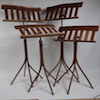I've got a janky garage/shop roof that I'm trying to get ready for the winter, and need a suggestion for some kind of filler material. The guy who built it was in the military probably in the early 60s and it seems like it was built to the standards of a field manual. The roof is sloped about 3 deg, which when it was new probably performed well, but a number of decades later and it ain't lookin so hot. Everything's under control insofar as major structural integrity is concerned. The problem is with some of the plywood that droops in spots between the joists. I'd like to secure a large tarp up there to give it the best chance possible over the winter, but if these dips aren't filled in before the tarp goes on there's gonna be lots of places that will harbor shallow pools of water weighing on the roof all winter.
What I have are a number of say 3 ft long runs between joists that are sunk about 2", and these are the places I'm trying to fill. My first idea was to use expanding foam but emptying out a can doesn't nearly fill one of these dips. Something with more volume is needed. So then I had the idea of using mulch, but that's got too much potential to absorb moisture and become too heavy. Thought about sawdust, but it's got the same potential to gain weight. And now my last idea is to use shipping peanuts. Although I don't think they'll end up being what I go with because of their cost and anticipated difficulty in working with them, they do happen to be a good example of a material that would fit the requirements of being light and resting absorbing water.
So that's where I'm at with this guys. Any ideas on some kind of filler material I haven't thought of?
Last thing is, I'm trying to figure out a material I could cut to about 3'x5' and use as an outside tabletop, something that rain won't effect. 3/4" melamine would work great insofar as utility is concerned but obviously wouldn't work due to not being weatherproof. Any suggestion for a material here?
Thanks.






 Reply With Quote
Reply With Quote






